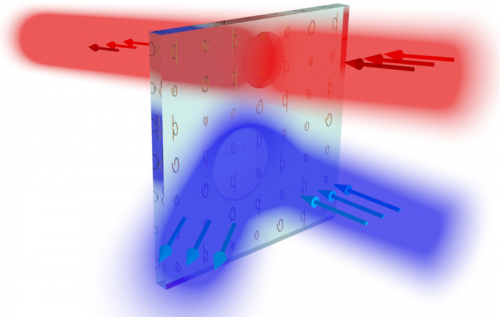March 11, 2015 report
Metamaterials used to make metamirrors capable of reflecting one frequency and ignoring all others

(Phys.org)—A small team of researchers working at Aalto University in Finland has discovered a way to create "metamirrors" capable of acting on a single radiating frequency while allowing others to pass through. In their paper published in the journal Physical Review Letters, the researchers describe how they embedded metamaterials in certain other materials allowing for the creation of metamirrors with interesting properties.
Normal mirrors reflect light back at an equal but opposite angle, which works well for some purposes. Over the past several years, scientists have discovered that applying metamaterials to the surface of a regular mirror allows for manipulating the reflective angle. In this new effort, the researchers have found that metamaterials could be used both for manipulating certain frequencies and for reflecting purposes while at the same time allowing other frequencies of light to pass through unchanged. With such a mirror it would be possible, for example, to make a mirror/window that allows normal and infrared light through, but not ultraviolet.
In their work, the researchers found that embedding tiny copper wires (which they call inclusions) inside of a clear material that normally allowed microwaves to pass through allowed them to create a mirror that could be used to reflect microwaves in ways they chose while also allowing light and other radiation to pass through unchanged. By manipulating the size and shape of the inclusion, the researchers could choose the frequency they wanted to impact and the reflection angle. The technique works, they explain because the microwaves cause the tiny wires to oscillate at the same frequency as the original microwaves, but only for a very short time—they are very soon released at the same frequency, but travel in a different direction. The team also created a metamirror that was capable of focusing all of the microwaves to a single point, as is normally done with a parabolic receiver.
The team reports that computer simulations showed that the technique could be used to reflect incoming radiation back in virtually any direction and note that such mirrors could find a variety of uses, such as single panels that perform multiple duties, e.g. serving as both a solar collector and radio wave receiver, or a single panel that could route different radio waves from space to different receivers, saving on costs.
More information: Functional Metamirrors Using Bianisotropic Elements, Phys. Rev. Lett. 114, 095503 – Published 6 March 2015, dx.doi.org/10.1103/PhysRevLett.114.095503
ABSTRACT
Conventional mirrors obey the simple reflection law that a plane wave is reflected as a plane wave, at the same angle. To engineer spatial distributions of fields reflected from a mirror, one can either shape the reflector or position some phase-correcting elements on top of a mirror surface. Here we show, both theoretically and experimentally, that full-power reflection with general control over the reflected wave phase is possible with a single-layer array of deeply subwavelength inclusions. These proposed artificial surfaces, metamirrors, provide various functions of shaped or nonuniform reflectors without utilizing any mirror. This can be achieved only if the forward and backward scattering of the inclusions in the array can be engineered independently, and we prove that it is possible using electrically and magnetically polarizable inclusions. The proposed subwavelength inclusions possess desired reflecting properties at the operational frequency band, while at other frequencies the array is practically transparent. The metamirror concept leads to a variety of applications over the entire electromagnetic spectrum, such as optically transparent focusing antennas for satellites, multifrequency reflector antennas for radio astronomy, low-profile conformal antennas for telecommunications, and nanoreflectarray antennas for integrated optics.
Journal information: Physical Review Letters
© 2015 Phys.org




















